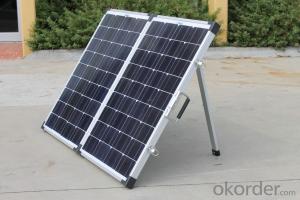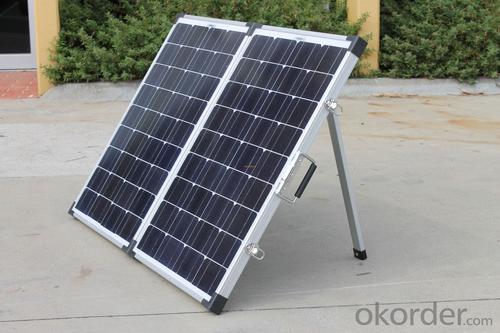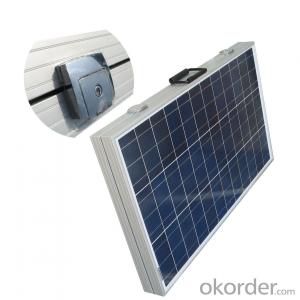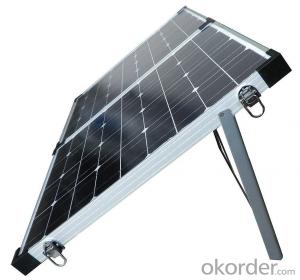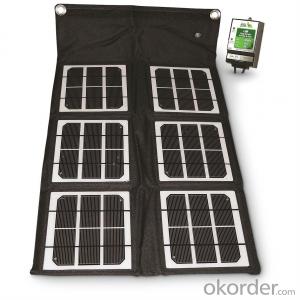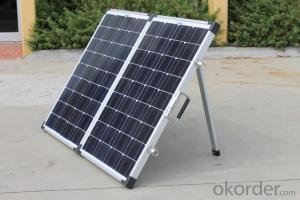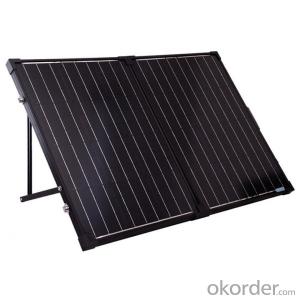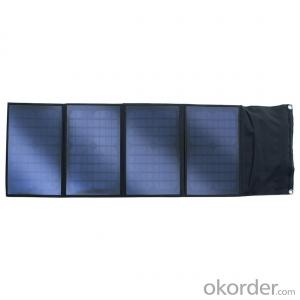Home Energy Solar Panels:150W Folding Solar Panel with Flexible Supporting Legs for Camping
- Loading Port:
- Shanghai
- Payment Terms:
- TT OR LC
- Min Order Qty:
- 1000 watt
- Supply Capability:
- 10000 watt/month
OKorder Service Pledge
OKorder Financial Service
You Might Also Like
Specification
Product Description
Folding module kits are designed to provide portable 12 volt power wherever you need it.PoPwer available from 20W to 240W
Features:
· Padded, moulded carry bag
· Heavy duty carry handle, hinges and clasps Stainless steel telescopic&adjustable legs
· Weatherproof solar charge controller with LED indicator
· 5m cable with heavy duty Anderson connectors between module-regulator & regulator-battery clamps
· All cabled up ready to use
· 2 year warranty
These kits are the ideal solution for 4WD, camping, caravaning, boating and recreational activities whereverpower is required for lights, small TV, camping fridge, pump or other small appliances.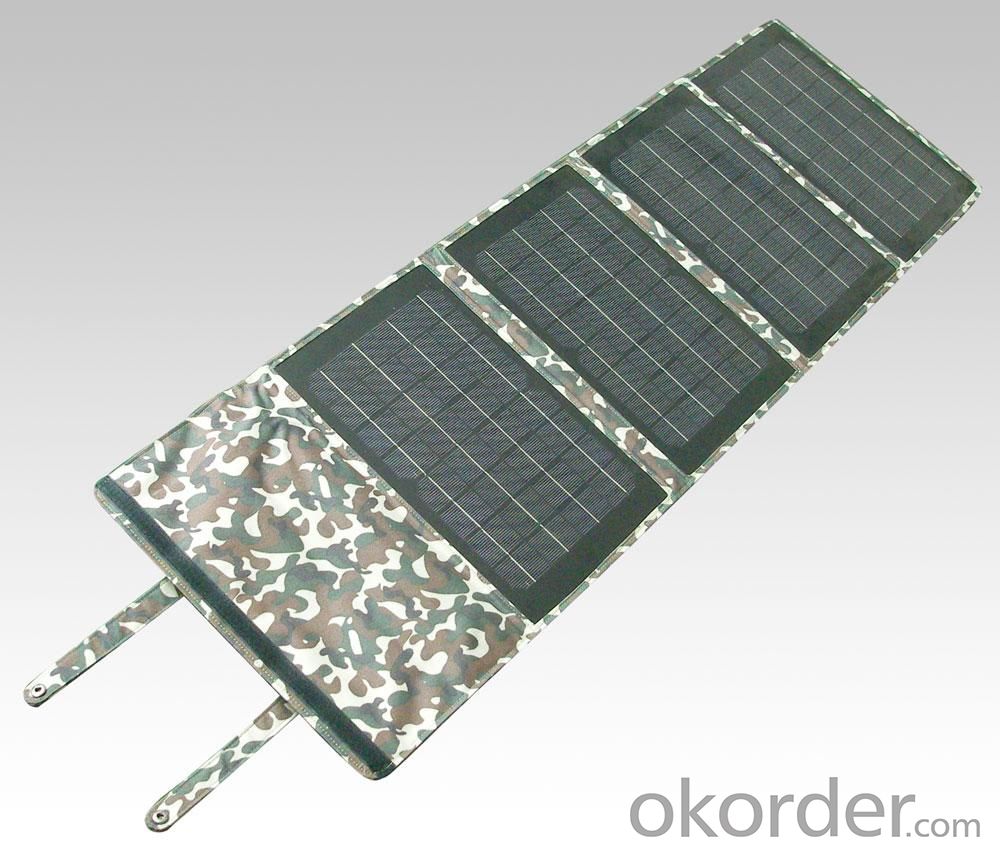
| Nominal Peak Power | 150W | 120W (2 x 60W) | 160W (2 x 80W) | 200W (2 x 100W) |
| Power tolerance | 3% | |||
| Cell type | Monocrystalline/Polycrystalline | |||
| Open circuit voltage (Voc) | 21.6V | |||
| Voltage at maximum power (Vmp) | 17.6V | 17.5V | 17.5V | 17.5V |
| Short circuit current (Isc) | 4.9A | 7.4A | 9.88A | 12.34A |
| Current at maximum power (Imp) | 4.54A | 6.86A | 9.14A | 11.42A |
| Maximum system voltage | 1000VDC | |||
| NOCT (Nominal Operating Cell Temperature) | 45 C +/-2 C | |||
| Operating temperature - module | -40 C to +85 C | |||
| Operating temperature – charge | -35 C to +55 C | |||
| Module folded size (mm) in carry bag | 505x550x60 | 505x825x80 | 505x1005x70 | 670x1005x70 |
| Module open size (mm) | 1014x550x30 | 1014x825x35 | 1014x1005x35 | 1344x1005x35 |
| Module net weight (kg) | 9.2 | 13 | 15.2 | 19 |
| Module gross weight (kg) | 11 | 16 | 19.4 | 23.2 |
| Solar charge controller | PWM 12V 10A; IP65 rated | PWM 12V 20A; IP65 rated | ||
- Q: when solar panels have served their purpose, what is done with them?
- Yes, okorder /... This is a link that might help you more! You can explore the website on every subject though, to ensure you get the best information possible! Hope this helps! Kintalia
- Q: I have seen DIY software which explains everything for novices. Specifically, how to build your own solar panels and tie them into your home electrical system for about $00 in parts.Has anyone tried doing this? Was it easy?
- Hi Mitch, Yes they are legitimate ans so much so the government will actually help you pay for them. Someone has already mentioned if you purchase them from your local solar panel installer they will not be cheap.They have come down in price a lot over the last couple of years. Yes you can build your own and no its not too difficult.You need to know in your own mind whether you just want to reduce your utility bill or come off the grid completly. The best solution is a combination of wind and solar power and yes you can build your own windmill as well and at the bottom her I will show you where to go to get easy non technical plans. Naturally the sun does not shine at night so your solar panels would not work then but windmills function 24/7 as long as there is wind. If you have nearby neigbours please be aware windmills do make some noise which might upset your neighbours and of course see if you need planning permission from the town. The solar panel plans show you how to set an 80w solar panel which of course would not be able to power your whole house,but once you have built one why not build loads more and each one will get easier to build. Wish you all the best.
- Q: This is the cenario. Your yearly energy use comes by mail and it states that the total amount of energy used your household is 7000kWh.Then you make the decision of switching to get solar panels. The question is what area should your solar panel be given that the average annual length of daylight is 2.0.
- It is not that simple. There are 3 main types of solar cells. Monocrystalline silicon is the most efficient and produces the smallest solar cells, and therefore the smallest panels. Poly-crystalline (or multi-crystalline) silicon produces the next most efficient type of cells and are a popular choice. Amorphous (or thin-film) silicon uses the least amount of silicon and also produces the least efficient solar cells. This means thin film system take up more area than the other two; an important factor to consider in relation to possible future upgrades; i.e. if you'll have enough space left to do so. The North (in the Southern hemisphere) or South (in the Northern hemisphere) facing roof collects the most energy. So this biases the roof area required. Your energy usage can be changed. Hot water (a major energy user) could be better using direct solar heating with peak demand boosting, either from mains or solar. There are other possibilities, either to reduce demand or to provide energy from other sources. Not all sunshine hours are equal. Hours around midday are far more productive than hours later in the day. This must be factored in.
- Q: Can solar panels be installed on a shaded area?
- Solar panels can still be installed in shaded areas, but they may not be as effective in generating electricity compared to panels installed in direct sunlight. The amount of shade and duration of shading throughout the day will impact the overall energy output of the solar panels.
- Q: I was just wondering what the minimum and maximm charging voltage and ampere is for li ion batteries. If i connect a solar panel, which only gets enough sunshine to generate voltage, will that still charge the battery, or would i have to series connect solar panels until they together reach 3,7volt?
- One lithium cell requires 4.2V to obtain its full charge, Never exceed 4.2V ! Output from solar panel if below 3.7V , nothing charge to lithium. Total charging time until the cell is full depending on the AH rate of cell and the charging current that solar panel can be provided. Suppose cell is rate 5AH, and the charging current from solar panel under full sun shine can maintain 0.5A ( use solar panel short circuit current rate from its specification as a reference ) , hence, 0 hours is enough. And be sure the solar panel can maintain 4.2V output at 0.5A . Remember, over charge lithium cell one time might reduce its life into half . Therefore, let the solar panel output passing through a precision regulator to maintain output is 4.2V is the best way, because, as cell reaches 4.2V , no more charging current is forced into cell ( automatic stop charging ). If you do not have the knowledge to make this simple variable voltage regulator with LM37K ( if you choose this way, buy solar panel output has at least 2V) , you may choose to do it manually by install a current meter and a variable resistor in series between the panel output to cell. By adjust the value of resistor, charging current can be controlled ( if you choose this way, buy solar panel output has as less as 6V ). Count the charging time with a clock and adjust the charging current from time to time to maintain 0.5A .
- Q: Ok so i'm writing this research paper on why solar panels are the best way to quot;go greenquot;. I need at least 5-7 reasons why they are good. and a common counterargument that i could defend. I've already come up with incentives and efficiency but i need a few more Please help its very important and worth half my grade
- I'm a big fan of solar panels, and we even have an array on our house, but I would have a hard time supporting the thesis that solar panels are the best way to go green. Conservation and efficiency are. Using less is better than making more. If someone has the money for panels, but their house is poorly insulated, their money would be better spent on insulation. Pretty much anyone in the solar industry would agree. And solar hot water makes sense over a much wider geographical range than solar electric.
- Q: a fiber optic network could distribute solar energy from warm states to the rest of the country. Using a Federally created program,the energy would be used through a trust program to benefit all of our citizens equally. It would create thousands of jobs and help us with our dependence on foriegn oil supplies. This is no different than work programs created by the Feds during the 930's depression era.
- It's not a matter of Federal money or Federal programs or attitudes of the government that keeps your grand plan for generating large amounts of electrical power using solar panel systems and distributing it country wide with fiber optics from becoming a reality. It's technology. Whatever optimistic speculations you may have heard or read, large scale, dependable generation of electrical power at steady high levels from solar cells is nowhere near a reality. Some of the big culprits are the variable atmosphere of the earth and the inefficiency of practical and economic solar cells. The conversion does not depend on the warmth of the states where generation might take place but on constant direct sunlight, unobscured by clouds in the atmosphere for most of every day, and on high efficiency solar cells. No states can depend on clear skies 365 days of the year and there's the little matter of night time, when nothing would be generated. Also, the electricity generated by solar panels cannot be carried by fiber optics since they carry electromagnetic energy (light), not electricity. What may be possible sometime in the not-too-distant future is the use of solar panels to supplement, not replace, conventional power generating systems on a local basis. It would not be required that they provide constant high levels of power every day, but only that they provide power when conditions were right, in order to perform the valuable role of cutting down on the use of fossil fuels in conventional generating systems. (The direct current generated by solar panels would have to be converted to alternating current or stored in batteries to accommodate our present methods and equipment for using electric power.) As soon as this becomes technically and economically feasible, we will not have to wait long to hear about it from the energy corporations and politicians.
- Q: if you know the area of the panel can u calculate for the wattage or voltage of the panel..
- You need to know how many solar cells are in the panel and what is the rated current each cell will produce. This information should be listed on the panel. Each cell will produce from 0.5 to 0.55 volts DC per cell and each cell will produce a current that is dependent on the size of the cell and the type of material the cell is made from. If the cells are connected in series then the voltage of each cell will add together, that is if you have 30 cells connected in series they should generate about 5 to 6.5 volts DC. If each cell generates .2 amps, then you multiply the voltage of 5 volts DC times .2 amps DC equals 8 watts of power. The current of each cell does not add together when you connect the cells in series only the voltage of each cell. If you connect the 30 cells in parallel then the current of each cell adds together but the voltage of each cell does not. That is 0.5 Volts DC times 36 amps equals 8 watts. The power (watts) produced will be the same. See our blog on the products page to see how to connect solar cells in series and in parallel. We also have a PDF file of solar cells and their rated output current sorted by watts per area and their manufacturer.
- Q: Do LED lamps ever go bad?What's the life expectancy of solar panels?
- LEDs last approximately 50,000 hours of operation, continuous or non-continuous, it doesn't matter. 50,000 hours. Solar panels will, theoretically, last until the end of time. The support structures will fail long before the panels themselves. Inverters, battery banks, op-amps, transformers, control boards, etc. will all fail long before a solar panel stops making juice.
- Q: i really need to know howbecause im building a solar powered car for science fair :]thank you!
- Hehe, if you want to build your own solar panel that looks like what you see on buildings, etc, you will probably need to be a multi-millionaire. Here is a quote from the first link in my sources list: The high-efficiency solar cells you can buy at Radio Shack and other stores are made from highly processed silicon, and require huge factories, high temperatures, vacuum equipment, and lots of money. But fortunately for you, there is a cheap way to make a solar panel yourself (see first link). I love the scitoys website, but I am not quite familiar with this particular experiment. It looks like a science fair project in itself! It also doesn't appear to put out nearly enough power to run even a small solar car. What I would recommend is buying a compact solar panel from Radio Shack or some other electronics store that you may know of. Type in solar in to the Radio Shack search box. The first item on the list may be useful to you (the solar panel battery combo). I am just guessing, though, since I don't know any of your requirements (voltage output, power output, size, etc). Also, buyer beware. This particular product has a pretty bad customer review... but then again, I find that people are more inclined to leave a bad review than a good one. Good luck... -Ubi
Send your message to us
Home Energy Solar Panels:150W Folding Solar Panel with Flexible Supporting Legs for Camping
- Loading Port:
- Shanghai
- Payment Terms:
- TT OR LC
- Min Order Qty:
- 1000 watt
- Supply Capability:
- 10000 watt/month
OKorder Service Pledge
OKorder Financial Service
Similar products
Hot products
Hot Searches
Related keywords
